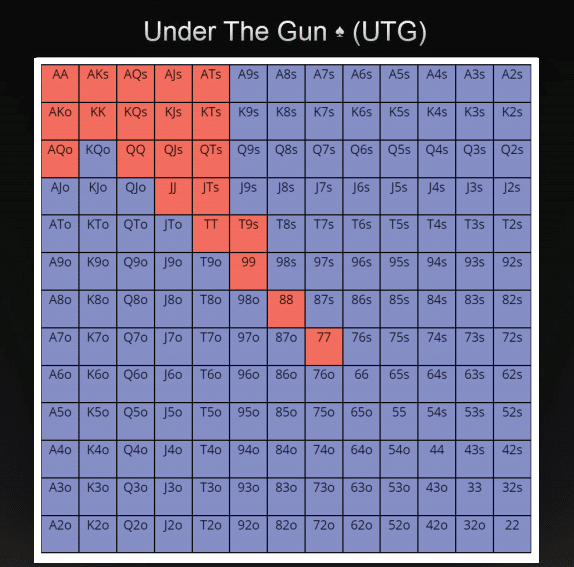Opening Hands Poker Chart

Have you ever found yourself mid-game staring at your HUD while facing an open from a player with an RFI stat of 21% and thought to yourself, “What hands are in his range?” Or while playing live, have you estimated that your opponent calls an open 40% of the time but didn’t know what hands comprise that range?
Charts are some kind of poker tables that show a spectrum of hands you should play with and what to do in any given situation with these cards. Each of them is made up of ranges. Chart of starting hands gives information on a preflop about what cards to choose for play and how to step into the play. Key for PokerStove Hand Range Charts: -Green for all the pairs -Red for suited hands (everything up and right of the pairs) These hands also have a little s after them -Grey for offsuit hands (everything down and left of the pairs) These hands also have a little o after them -Yellow for a hand that has been selected. The best hand from our chart, A A K K, is 33% to win, 41% to tie, and 26% to lose to the second-best hand, A A T J. This represents a 7% edge while in Hold'em it's 83 – 17 = 66%. It does get much better once you go down the list of top hands, but in essence, edges in Omaha are never very large. One aspect of the game of No-Limit Hold’em that causes beginning players much grief is deciding which hands to play and which hands to dump. Given that well over half of your profitability in NL Hold’em is based on hand selection alone, we have developed these charts to.
So, the game can be beaten, and be profitable for a winning player. But even a winning player will suffer extreme swings. It's easy to understand the amount of variance you should expect in Omaha by imagining a game of Hold'em in which you move all-in preflop every hand, each time holding the same hand of A-K, and your opponent calls every hand holding Q-T.
Well, I’ll show you the easy way to learn poker ranges for quick reference in the future.

First, here’s a Poker Range Chromatic I created for my own use:
Poker Hands Chart Printable
I wanted to learn where each hand falls within a range and the above is what I came up with. I used Flopzilla to figure out which hands fall within each percentage grouping. I just started with a 5% range, then went by 5’s up to 40%, then followed that with 10’s up through 60% then 75%. I used color coding to help visualize the ranges.
I then took the following steps to learn the ranges:
- Printed the chromatic I made, laminated and posted it on the side of my computer monitor for quick in-game reference.
- Created 11 flash cards for use each night as part of my warm-up, and I put the following on them:
- For one week during my study session I would do a hand history review from the previous night’s session and each time I faced an open I looked at their RFI Stat in that position and determined what range it fell under. I would say aloud, “20% in the CO… that’s 22+, A7s+, ATo+, K9s+, KTo+, Q9s, QTo+, JTo and 98s+.” That’s all there was to it. After that first week I got them all down. This is especially helpful when playing live as I can’t glance to the side of my screen to get an estimate on an opp’s range. Now, it’s easier to remember the bottom of the ranges as you’re trying to learn these. So, when thinking about 20%, the bottoms are 33, A7s, ATo, Q9s, JTo and 98s. If you just remember those 6 hands for 20%, you know it includes everything better than those. So if the question arises for a hand like K8s, you know that K9s is the bottom at 25% and K7s is the bottom of 30%, so it’s within the 30% range and just under the 25% range.
Opening Hands Poker Chart Printable
Please let me know if you would make tweaks to these ranges as I always love feedback.
Study hard and make your next session the best one yet!

Opening Hands Poker Charts

Opening Hands Poker Chart
- The 12 Days of Christmas 2020 Podcast Episodes - December 14, 2020
- Strategies and Action Steps from the Quick Wins Poker Course - November 24, 2020
- How to Quickly Understand Online Tournament Players – Podcast #318 - November 18, 2020